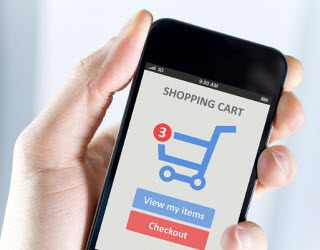IBM report shows that mobile traffic and shopping is on the rise in the US
Mobile now accounts for nearly half of all online retail traffic in the United States, according to the latest IBM Digital Analytics Benchmark. The report highlights the growing importance of the mobile space and how it is having a major impact on commerce in the digital world. The report makes note of the mobile commerce activity on Valentine’s Day, showcasing an increase in mobile shopping over what was recorded on the same day in the previous year.
Mobile traffic accounts for nearly half of all online retail traffic this year
According to the report, online shopping, as a whole, grew by 10% on Valentine’s Day. This may be due to numerous factors, including cold weather and powerful storms in some parts of the country. The report shows that mobile traffic accounted for 46.5% of all online traffic, highlighting the fact that many consumers are now using their smartphones and tablets to shop online. Higher traffic does not represent more sales, however.
Mobile commerce still represents a small portion of digital sales when compared to PC
 The report shows that mobile commerce represented 23% of all online sales, which is a 35% increase over mobile commerce sales last year. Mobile still represents a relatively small portion of online retail sales, however, as sales made from PCs remain the most significant force in online retail. The report shows that tablet users typically spent more than their smartphone counterparts. Tablet users spend an average of $98.56 per order, whereas smartphone users spent an average of $92.37 per order.
The report shows that mobile commerce represented 23% of all online sales, which is a 35% increase over mobile commerce sales last year. Mobile still represents a relatively small portion of online retail sales, however, as sales made from PCs remain the most significant force in online retail. The report shows that tablet users typically spent more than their smartphone counterparts. Tablet users spend an average of $98.56 per order, whereas smartphone users spent an average of $92.37 per order.
Mobile commerce continues to thrive because of its convenient nature
While PC still dominates the online retail space, mobile commerce is beginning to become a more prominent force. Many consumers are opting to shop for and purchase products from their mobile devices because of how convenient such a practice is. In the coming years, it is likely to become more common for consumers to participate in mobile commerce, especially during the holidays, when they want to avoid crowds and enjoy a convenient shopping experience.
A study has shown that 55 percent of retailers feel that smartphones are sending shoppers into stores.
A new survey conducted by RSR Research has revealed that brick and mortar retailers don’t necessarily feel that smartphones are working against them, as mobile marketing is working effectively to send foot traffic back into their shops.
This has also taken some of the edge off the threat that some have felt from e-commerce giants.
The responses to the survey showed that 55 percent of businesses feel that mobile marketing is sending more consumers into their stores in order to make purchases there, in person. At the same time, they also stated that this new advertising channel could make things more challenging for them along the way, if it is to grow into a larger part of doing business. So far, the largest challenge that it presents is actually the capability for stepping into mobile, in addition to actually wanting to boost online traffic while meeting the demands of customers that are associated with making those changes.
The survey results also pointed out that there are differing opinions on mobile marketing among businesses.
 The survey pointed out that there are two different categories of businesses, which they called “laggards” and “winners”. They explained that, depending on the type of business, the companies are likely to have different priorities with regards to the use of mobile advertising. The report on the survey explained that the companies that are in the “laggards” category, half feel that not knowing the expectations of the consumer in terms of smartphone ads could be the biggest challenge. Comparatively, only 38 percent in the “winners” category felt the same way.
The survey pointed out that there are two different categories of businesses, which they called “laggards” and “winners”. They explained that, depending on the type of business, the companies are likely to have different priorities with regards to the use of mobile advertising. The report on the survey explained that the companies that are in the “laggards” category, half feel that not knowing the expectations of the consumer in terms of smartphone ads could be the biggest challenge. Comparatively, only 38 percent in the “winners” category felt the same way.
Moreover, among the “winners”, 44 percent were focused on engaging with different groups of consumers in order to push sales upward. Furthermore, 21 percent felt that it was possible that mobile technology could be moving too fast to keep up. Equally, among the “laggards”, 20 percent said that they wanted to engage with customer groups and 0 percent felt that tech was moving too rapidly.
Both groups of businesses felt that mobile marketing was becoming an increasingly important tool and that it would only rise in its popularity over time.
 The report shows that mobile commerce represented 23% of all online sales, which is a 35% increase over mobile commerce sales last year. Mobile still represents a relatively small portion of online retail sales, however, as sales made from PCs remain the most significant force in online retail. The report shows that tablet users typically spent more than their smartphone counterparts. Tablet users spend an average of $98.56 per order, whereas smartphone users spent an average of $92.37 per order.
The report shows that mobile commerce represented 23% of all online sales, which is a 35% increase over mobile commerce sales last year. Mobile still represents a relatively small portion of online retail sales, however, as sales made from PCs remain the most significant force in online retail. The report shows that tablet users typically spent more than their smartphone counterparts. Tablet users spend an average of $98.56 per order, whereas smartphone users spent an average of $92.37 per order.
 The survey pointed out that there are two different categories of businesses, which they called “laggards” and “winners”. They explained that, depending on the type of business, the companies are likely to have different priorities with regards to the use of
The survey pointed out that there are two different categories of businesses, which they called “laggards” and “winners”. They explained that, depending on the type of business, the companies are likely to have different priorities with regards to the use of 